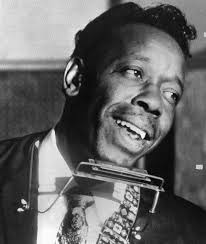American blues musician (1924–1970)
Musical artist
Slim Harpo (born James Isaac Moore; January 11, 1924 – January 31, 1970)[1][a] was an American blues musician, a leading exponent of the swamp blues style, and "one of the most commercially successful blues artists of his day".[2] He played guitar and was a master of the blues harmonica, known in blues circles as a "harp". His most successful and influential recordings included "I'm a King Bee" (1957), "Rainin' in My Heart" (1961), and "Baby Scratch My Back" (1966), which reached number one on Billboard's R&B chart and number 16 on its broader Hot 100 singles chart.
Life and career
Moore was born in Lobdell, Louisiana,[3] the eldest child in his family. After his parents died he worked as a longshoreman and construction worker in New Orleans in the late 1930s and early 1940s. Influenced in style by Jimmy Reed, he began performing in Baton Rouge bars using the name "Harmonica Slim", and also accompanied his brother-in-law Lightnin' Slim in live performances.[1][2][4][5]
He started his recording career in March 1957, working with the A&R man and record producer J. D. "Jay" Miller in Crowley, Louisiana. To differentiate himself from another performer called Harmonica Slim he took his wife's suggestion and adopted the name Slim Harpo.[6] His first solo release, for Excello Records, based in Nashville, Tennessee, was "I'm a King Bee", backed with "I Got Love If You Want It" in 1957. Harpo played guitar in his live shows, but he usually used other guitarists when recording. The record was a regional hit, but failed to make the national charts.[4] He followed up with several more singles for Excello before having his first chart hit, "Rainin' in My Heart", in early 1961. The record reached number 17 on Billboard's R&B chart and number 34 on its Hot 100,[7] and it was followed soon after with an album of the same name and additional singles. Many of his songs were co-written with his wife, Lovelle Moore, although she never received credit.[5][6]
Never a full-time musician, Harpo owned a trucking business during the 1960s.[5] According to writer Ryan Whirty, "Harpo and his band needed to tour constantly and play as much as possible; times were frequently lean financially, and the men had to scrape up whatever they could get."[2] But, by 1964, several of his songs had been released on albums and singles in the UK, and British rock bands began to include versions of his songs in their early repertoires. British Merseybeat/R&B group The Moody Blues reportedly took their name from an instrumental track of Slim's called "Moody Blues".[5] Critic Cub Koda wrote of his appeal:
Harpo was more adaptable than [Jimmy] Reed or most other bluesmen. His material not only made the national charts, but also proved to be quite adaptable for white artists on both sides of the Atlantic ... A people-pleasing club entertainer, he certainly wasn't above working rock & roll rhythms into his music, along with hard-stressed, country & western vocal inflections ... By the time his first single became a Southern jukebox favorite, his songs were being adapted and played by white musicians left and right. Here was good-time Saturday-night blues that could be sung by elements of the Caucasian persuasion with a straight face.[1]
He had his biggest commercial success in 1966, when the predominantly instrumental "Baby Scratch My Back" reached number one on the R&B chart and number 16 on the broader chart. Harpo described it as "an attempt at rock & roll for me" and was again produced by Miller. However, disagreements with Miller and a change in the record company's ownership led to two follow-ups, "Tip On In" and "Tee-Ni-Nee-Ni-Nu", being recorded in Nashville with new producer Robert Holmes.[4] Both made the R&B charts.[7]
He recruited Lightnin' Slim for his touring band in 1968,[4] and toured widely in the late 1960s, mainly reaching rock audiences. With his first scheduled tour of Europe and recording sessions already planned, "one of the cleanest living bluesmen of his era"[1][6][b] died suddenly of a heart attack in Baton Rouge in January 1970 just 20 days after his 46th birthday. He was buried in Mulatto Bend Cemetery in Port Allen, Louisiana.
Influence
Music critic Cub Koda noted that his songs "also proved to be quite adaptable for white artists on both sides of the Atlantic, including the Rolling Stones, Yardbirds, Kinks, Dave Edmunds with Love Sculpture, Van Morrison with Them, Sun rockabilly singer Warren Smith, Hank Williams, Jr., and the Fabulous Thunderbirds".[1] The Slim Harpo Music Awards, awarded annually in Baton Rouge, are named in his honor. Proceeds from the awards benefit the "Music in the Schools" outreach program.[8]
A biography, titled Slim Harpo: Blues King Bee of Baton Rouge, by UK blues scholar Martin Hawkins was published in 2006. David Fricke of Rolling Stone magazine described the book as "a passionate, encyclopedic triumph, bringing the enigmatic Harpo to life and tracing his remarkable mainstream ascension – from the rich central-Louisiana blues scene to gigs at the Fillmore East – with deep local research and detailed portraits of the singer's peers, sidemen and record-business associates."[9]
